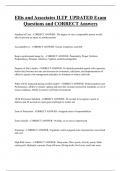Ellis and Associates ILTP UPDATED Exam
Questions and CORRECT Answers
Standard of Care - CORRECT ANSWER- The degree of care a responsible person would
take to prevent an injury to another person
Accountable to: - CORRECT ANSWER- Guests, Employer, and Self
Keep a professional image by: - CORRECT ANSWER- Punctuality, Proper Uniform,
Preparedness, Pleasant, Attentive, Vigilant, and Knowledgeable
Purpose of E&A Audits - CORRECT ANSWER- To identify potential aquatic risk exposures
before they become an issue and increase the awareness, education, and implementation of
effective aquatic risk management principles to eliminate or reduce said risks
What will be inspected during an E&A Audit? - CORRECT ANSWER- Professionalism and
Performance, Ability to remain vigilant and meet the swimmer protection standards, Level of
rescue readiness, Ability to protect self from environment
10/20 Protection Standard - CORRECT ANSWER- 10 seconds to recognize a guest in
distress and 20 seconds to reach guest and begin to render aid
Zone of Protection - CORRECT ANSWER- Assigned areas of responsibilities
Zones should: - CORRECT ANSWER- Overlap, so no area is unprotected
Scanning: - CORRECT ANSWER- Vigilantly watch assigned zone of protection, move head
and eyes
High Risk Areas: - CORRECT ANSWER- Deep water, Wave pools, Activity pools, Slide
catch pools, Hydraulic currents, Drop off areas, Diving wells, Pool exits, and Lake areas
, High Risk Guests: - CORRECT ANSWER- Children between 7 and 12 and those attended by
adults, shorter individuals who may wade into deep water, People who can't swim,
Intoxicated guests, Guests with extreme body proportions, Elderly, Disabled guests, and those
not dressed to swim
High risk times: - CORRECT ANSWER- Mid-day, Holidays, and extremely hot days
Drowning Process - CORRECT ANSWER- Surprise, Involuntary breath holding,
Unconsciousness, Hypoxic Convulsions, Clinical Death
Active Drowning - CORRECT ANSWER- GiDs may struggle on the surface for a short
period of time before submerging
Passive (Silent) Drowning - CORRECT ANSWER- GiDs can slip quickly and silently under
water and do not struggle on the surface
Recognizing a Guest in Distress - CORRECT ANSWER- Body Position: diagonal or vertical.
Movement: Little or no forward movement. Appearance: All effort to staying above water,
eyes may be open or tightly closed. Breathing: head held back to keep mouth above water
Scanning Techniques: - CORRECT ANSWER- 2 step, "head to shoulder, head to chest, head
to shoulder and the rest."
If you don't know, - CORRECT ANSWER- GO
Time span for complete drowning process - CORRECT ANSWER- Seconds to Minutes
Do children or adults go through the drowning process faster? - CORRECT ANSWER-
Children
True or False: Dry Drownings occur more frequently than Wet drownings. - CORRECT
ANSWER- False
What is a Wet Drowning? - CORRECT ANSWER- When a GiD has been submerged long
enough to allow the epiglottis to relax due to a lack of oxygen





